The two varieties of hard copper pipe used in most domestic water supply plumbing are type M and type L. Understanding L vs M copper difference is critical for appropriate installation and use.
For water supply piping, manufacturers create hard and soft copper pipes. Soft copper pipe, often known as tubing, bends easily without the use of equipment.
Even without using any tools, a soft copper pipe will bend readily. As a result, copper pipes are often known as tubing. Pipes constructed of the hard form of copper, on the other hand, are rigid and must be bent with specific tools. Therefore, rather than bending hard copper pipes, they are chopped and connected to form a junction.
L vs M Copper Pipes

L and M copper pipes differ in thickness. L copper tubing is thicker compared to their M counterparts. When applied to household water supply or structure, L copper pipes endure longer than M copper pipes. Because L pipes are more pricey than M pipes, M copper pipes are frequently preferred.
This blog will attempt to explain all you should know about the distinctions between the four categories of copper pipes, when each should be used, and how to determine if you should use L or M copper pipes.
Copper Pipe Types
Varieties L, M, DWV, and K are the four types of copper pipe offered by manufacturers. The relative pipe wall thickness is partially indicated by these letters. The wall thickness of a pipe is determined by its size [1].
The letter identifiers are also used to match the color of a pipe to the type of pipe it represents. The hue helps to distinguish the copper pipe type. Type K is represented by green, type L is represented by blue, type M is characterized by red, and type DWV is represented by yellow. Type L copper pipes are thus referred to as blue, while type M copper pipes are referred to as red.
K copper pipes are the only form of pipes installed underground. Water is delivered via L copper pipes, whereas heat is delivered via M copper pipes. DMV pipes aren’t utilized for water delivery and have no pressure rating, which means that they can burst even at 1 PSI .
DWV pipes are mostly seen in older residences and have been phased out in favor of plastic pipes that are less expensive and easier to work with. M pipes can be adopted for water supply and heat distribution.
Copper pipes have a narrow strip of color and text on the outside to identify the type of pipe. L copper pipes, for example, will have blue writing or a thin line of blue paint on them.
Pressure Rating
Under pressure, water flows through pipes. Water must also be pumped at relatively high pressure from the ground to a showerhead or above the kitchen or bathroom.
Each pipe category is stress-tested in a laboratory to evaluate its performance under different water pressures. Pipes, on the other hand, have a width and a thickness, which might be perplexing since a large tube with thin walls is less able to resist pressure.
The nominal size of a rigid copper pipe is always 1/8 inch less than the actual outer diameter (OD) [2]. A 1/2-inch copper pipe, for example, has a 5/8-inch outside diameter. This is true of all three common new pipe types: K, L, and M.
The copper pipe’s internal diameter (ID) is defined by the pipe’s wall thickness, which varies depending on the pipe type. Therefore, the kind of copper tubing specified for any purpose, the setup, the conditions of service, and the regional building code requirements may all be influenced by the internal or external fluid pressure.
Generally, the greater the pipe thickness – not the diameter – the more water pressure it can handle than thinner pipework. Under the same conditions, pipes having thicker walls will endure longer than tubes with thinner walls.
The fundamental distinction between types M and L is the thickness of the wall and the pressure rating. Half-inch and three-quarter-inch are the most popular sizes. The wall thickness of type M half-inch pipe is 0.028 inches, while type L is 0.040 inches. The wall thickness of Type M three-quarter-inch pipe is 0.032 inches, while Type L is 0.045 inches.
Type L is more expensive than type M. Because Type L has thicker walls, it weighs more and consumes more copper, resulting in higher manufacturing and transportation costs.
Similar types and sizes of copper pipes have the same outer diameter, allowing them to be connected with the same fittings. Because of the varied thickness of the walls, the internal diameter varies by type. For example, the inside diameter of half-inch type M is 0.569 inches, while type L is 0.545 inches.
Applications of Copper Pipes
Although all pipe types are acceptable for plumbing, DWV should not be utilized as a water supply pipe because it does not have a pressure rating. The only kind of copper pipe that can be buried is Type K, or greenish copper pipe, which is commonly used to convey water into a home.
The water system pipes in residences are Types M, and L. Type L has thicker walls and can withstand higher pressures. Only type L is permitted in some municipal codes, while type M is prohibited. However, the International Building Code approved both L and M and type K for use as water supply pipes.
Some local plumbing laws only permit the use of type L in residences and prohibit the use of type M. International building codes, on the other hand, accept the use of L, M, and K pipes for water delivery.
L vs M Copper Pipes – Residential Suitability
Unless municipal rules state differently, copper pipe for indoor domestic water supply lines can be type M or L. Both are rated above the typical water pressure levels found in public water supply systems. However, because of its higher cost, type K pipe is mainly limited to underground water supply pipes.
For most homes, the cost difference between type M and type L is significant enough that using type M rather than type L for substantial improvements makes sense. Before beginning a project or purchasing building materials, check your regional code requirements for construction materials and permits.
Which One To Use?
In general, type L copper pipes should be used for water delivery in a structure. However, most jurisdictions (but not all) accept Type M copper pipes for water supply. Type L copper pipes, on the other hand, survive longer since they are thicker and do not require replacement as frequently as type M copper pipes.
Type L and Type M copper pipes can be found on the home department shelf. The difference is in the copper pipe sizes’ wall thickness and thus the pressure they can withstand.[3]
You may utilize the same copper connectors because the external dimensions are similar. You also cut and sweat them with the same tools, materials, and procedures. [4]
Type L is commonly used underground in water heating systems, commercial plumbing, and gas lines (where permitted). However, most plumbers utilize the less expensive Type M for residential installations: “Type L pipe should last 300 years, Type M only 250,” one said. But confirm with your construction inspector; some places require type L.
Copper pipes can be damaged by acidic water. After testing, if you have a well and discover that the water is acidic, you should use a Type L pipe with a thicker wall or “plastic” CPVC pipe and fittings. Even in sections of the country where the water is acidic, most “city water” is adjusted to address this problem.
However, seasoned plumber Charlie Avoles believes that PEX is the finest replacement for copper (flexible plastic pipe). “Many features of PEX appear to be stronger than copper, and PEX does not appear to be as frail as CPVC with use and exposure to UV radiation.”
Some authorities specify the use of Type L pipes
Copper pipes of type L or type M can supply water throughout a home worldwide. However, in some areas, type L pipes are required.
The main cause is high water pressure, which some public water sources require to meet demand. In addition, l copper pipes are thicker than M copper pipes and can handle more stress. As a result, please consult a professional plumber in your region or consult the building regulations on your local government’s website before you buy them.
It’s generally better to consult a plumber by phone or email because finding particular information can be difficult. However, you should ensure that your project complies with local construction codes. If it is inaccurate, you will be responsible for replacing them. As a result, it’s good to double-check everything before setting up or upgrading copper pipes.
Read Next: Water Pipes Banging At Night
Bottom Line
Type L copper pipe is a medium-weight pipe commonly used for home water pipes. If local codes allow, type M can be utilized subterranean or for light household water lines.
Before beginning any project, double-check your local and state codes. Take all necessary safety precautions. This content has been thoroughly checked for correctness and security.

Michael Davis is a heating & plumbing expert who currently works as independent contractor in SC. He also writes for Plumbertip.
For almost 10 years he worked on various plumbing tasks across South Carolina.






